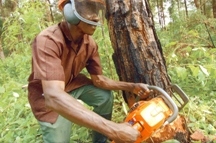Statistics about religions and the environment
 |
 |
 |
The faiths own or manage some five percent of forests. This picture is taken from a project in Mozambique, part financed by the Swedish Lutheran churches, to reforest, and manage ecologically, nearly 100,000 hectares of devastated land, in one of the poorest dioceses in the country. |
Percentages85 percent.
The proportion of the world's population to whom the religions of the world reach out.
More than 50 percent
The percentage of schools worldwide that are founded, funded or run by the faiths.
More than 50 percent
The proportion of the world's tourist destinations and most active tourism enterprises (in terms of pilgrimage in particular).
Approximately 48 percent
The estimate of land in Lebanon owned by the Maronite Church.
Approximately 15 percent
The estimate percentage of forests considered sacred over which faiths have influence.
More than 7 percent
The proportion of all international financial investments controlled or owned by the faiths.
7 percent
The approximate proportion of the habitable surface of the planet owned by the major faiths. (Atlas of Religion, p.75)
6 percent.
Buddhists make up nearly 6 percent of the world's population.
5 percent.
The proportion of forests owned or managed by the world's faiths.
Dollars and Pounds$250 billion
The amount of assets estimated to be owned by Islamic financial institutions, and invested according to Islamic principles. (Atlas of Religion, p.75)
$110 billion
 |
 |
 |
Buddhists make up almost 6 percent of the world's population. |
The combined portfolios of faith groups investing ethically through ICCR. (Atlas of Religion, p.76)
Numbers2.1 billion
The number of Christians worldwide.
1.34 billion
There are 1.34 billion Muslims worldwide, 20 percent of the world's population.
950 million
Hinduism is the world's third largest religion with over 950 million Hindus worldwide.
24 million
Over 90 percent of the 24 million Sikhs live in India, mainly the Punjab.
13 million
With over 13 million Jews worldwide, over 5 million live in Israel.
1.5 billion
The estimated number of Bibles in the world.
72 million
The number of new Bibles distributed worldwide in 2005.
A lot less than a million
The number of Bibles printed each year on recycled paper or on paper from ecologically-managed forests.
On Assets**** Specialist fund manager CCLA is responsible for £3 billion of Church of England investments. (Church Times, 3 October 2008.) According to the CCLA: "We apply the ethical investment policies set by the Church of England’s Ethical Investment Advisory Group. We do not invest in companies that promote pornography or supply armaments. In addition, we do not invest in companies with significant business activities involving gambling, tobacco, alcoholic beverages, non-offensive military equipment or home credit".
On Media**** Some 18.8 percent of Iraq's population, or 5.3 million people, watch Christian Satellite Television SAT-7, with 2.6 million watching on a regular basis, according to a March 2009 survey by the independent audience research group Intermedia. The proportion of Christians in Iraq is around 2 percent (600,000 out of a population of 28 million population) showing that this faith-based station was reaching far beyond its religious bounds.
On Energy **** Churches in Germany have learned that their buildings are responsible for an annual 18 million tonnes of carbon emissions — about 3 per cent of the energy-related total for the country. The Times, September 10, 2008.
General Environment Statistics 2.3 million people
The number of people employed by wind, solar and other renewable energy industries worldwide - more than the oil and gas industries combined. In 2008 for the first time, wind, solar and other renewables accounted for more investment worldwide than generating electricity from coal and gas. Geoffrey Lean, Daily Telegraph, June 12 2009.
22 million people
The number expected by the International Labour Organisation to be employed by the renewable energy industry by 2030. ILO estimate.
75 per cent
The proportion of the 2.6 billion people who live on less that $2 a day who are dependent upon local natural resources for their livelihoods. Threats such as climate change and ecosystem degradation are beginning to strain those livelihoods, and it will be necessary to shape development strategies that build resilience against such threats and ensure stable and prosperous communities. World Resources 208/UNEP.
11,000
The approximate number of people who attended the Climate Summit (COP 13) in Bali in 2007. This included some 3,500 government officials, more than 5,800 representatives of intergovernmental and non-governmental organisations and nearly 1,500 media representatives. UN Framework Convention on Climate Change.
9,300
The approximate number of people who attended the UN Climate Change Conference in Poznan, Poland in December 2008.
$650 million
WWF's approximate annual income exceeding ; Greenpeace deploys a bigger navy than three quarters of the world's governments. Geoffrey Lean, Daily Telegraph, June 12 2009.
Water, Sanitation and Hygiene Statistics
Link
here for details of water, sanitation and hygiene statistics and a visit to Nairobi slums ahead of a joint ARC-EMF-IRC Faith in Water Conference at Sarum College, Salisbury from 5-7 July 2009.
*** References: unless otherwise stated the references for this webpage can be found at Atlas of Religion written by Joanne O'Brien and Martin Palmer.
|

